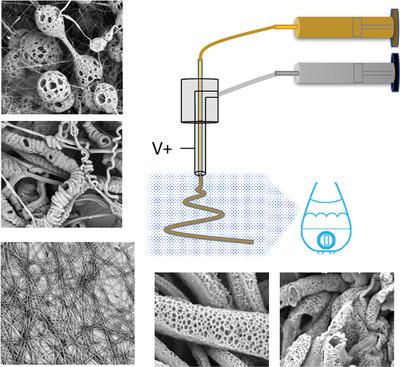当前位置:
X-MOL 学术
›
Macromol. Mater. Eng.
›
论文详情
Our official English website, www.x-mol.net, welcomes your feedback! (Note: you will need to create a separate account there.)
Core–Sheath Wet Electrospinning of Nanoporous Polycaprolactone Microtubes to Mimic Fenestrated Capillaries
Macromolecular Materials and Engineering ( IF 3.9 ) Pub Date : 2020-06-16 , DOI: 10.1002/mame.202000180 Yingge Zhou 1 , George Z. Tan 1
Macromolecular Materials and Engineering ( IF 3.9 ) Pub Date : 2020-06-16 , DOI: 10.1002/mame.202000180 Yingge Zhou 1 , George Z. Tan 1
Affiliation

|
Formation of capillary vessel structures in scaffolds is critical for engineering various tissues and organs. Various biofabrication techniques are developed in recent years to create scaffolds integrated with perfusion channels. However, rapid fabrication of artificial capillary vessels (<10 µm) still remains challenging. In this study, a novel electrospinning approach is developed to fabricate nanoporous polycaprolactone microtubes as potential functional capillaries. The results show that ambient environment parameters and solution properties affect the pore formation and tube morphology. Porous microbeads, helical fibers, and microtubes were fabricated under different processing conditions. The optimal tubular structure is obtained with consistent viscosities between the core and the sheath solutions. The biomimetic nanoporous microtubes hold great potential for vascularization in tissue engineering.
中文翻译:

纳米多孔聚己内酯微管的芯-鞘湿静电纺丝模拟有孔的毛细血管。
支架中毛细血管结构的形成对于工程化各种组织和器官至关重要。近年来,已经开发了各种生物制造技术来创建与灌注通道整合的支架。但是,快速制造人造毛细血管(<10 µm)仍然具有挑战性。在这项研究中,开发了一种新颖的静电纺丝方法来制造纳米多孔聚己内酯微管作为潜在的功能性毛细管。结果表明,周围环境参数和溶液性质会影响孔的形成和管的形态。在不同的加工条件下制造了多孔微珠,螺旋纤维和微管。获得的最佳管状结构在芯层和皮层溶液之间具有一致的粘度。
更新日期:2020-07-16
中文翻译:

纳米多孔聚己内酯微管的芯-鞘湿静电纺丝模拟有孔的毛细血管。
支架中毛细血管结构的形成对于工程化各种组织和器官至关重要。近年来,已经开发了各种生物制造技术来创建与灌注通道整合的支架。但是,快速制造人造毛细血管(<10 µm)仍然具有挑战性。在这项研究中,开发了一种新颖的静电纺丝方法来制造纳米多孔聚己内酯微管作为潜在的功能性毛细管。结果表明,周围环境参数和溶液性质会影响孔的形成和管的形态。在不同的加工条件下制造了多孔微珠,螺旋纤维和微管。获得的最佳管状结构在芯层和皮层溶液之间具有一致的粘度。



























 京公网安备 11010802027423号
京公网安备 11010802027423号